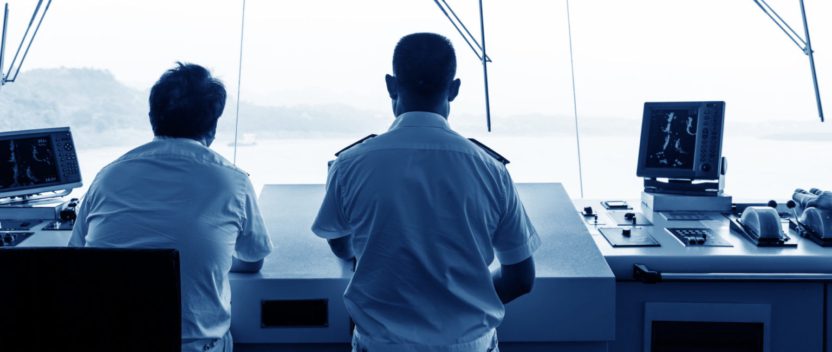Wireless ships, seawater antennas, new satellites and sextants
Technology continues to drive forward in the shipping industry despite the difficult market conditions for bulk carriers, containerships and in offshore. From satellites to seawater antennas and using sextants, there was plenty to keep us occupied. Others think that the era of connectivity is a bad thing for crew but there are much more radical changes being proposed on the bridge.
EPIC up and away
US headquartered satellite network operator Intelsat launched the first of its EpicNG series of High Throughput Satellites. Blasting off from French Guiana aboard an Ariane 5 rocket, Intelsat 29e will bring HTS capacity in C-band and Ku-band to North and Latin America and the North Atlantic region.
EpicNG is Intelsat’s all-digital next generation satellite platform combining wide and spot beams with frequency reuse technology and a digital payload, which the company says provides significant improvements on its analogue predecessors. The satellites feature steerable beams, allowing capacity to be shifted to match usage needs in a particular regions.
With the maritime sector identified by the company as a key future growth area the satellite has been designed with mobility in mind as Intelsat looks to increase its market share of maritime VSAT services.
Now you sea it
Japan’s Mitsubishi Electric Corporation announced the development of a unique type of communications antenna made from seawater.
The SeaAerial system shoots a column of seawater into the air to create a conductive plume for the transmission and reception of radio-frequency waves and is even capable of receiving digital terrestrial broadcasts for television.
Seawater can be safely used as an antenna if it is insulated, so Mitsubishi Electric developed an insulated nozzle with a quarter-wavelength tube that transmits radio waves to the antenna even when the plume is physically connected to the sea surface.
The ratio of radiated power to input power, a measure of the antenna’s efficiency, is a major challenge to system design but simulations to determine the ideal diameter have resulted in an efficiency level of 70% according to MEC.
Wartsila and Cavotec go wireless
Marine engine maker Wärtsilä and port equipment specialist Cavotec have agreed a deal to jointly develop the world’s first ‘combined induction charging and automatic mooring concept’ otherwise known as wireless charging.
Wärtsilä says it has developed wireless charging based on inductive power transfer and Cavotec will provide the automated mooring system to manage the physical connection between the ship and the shore. The integrated wireless charging/mooring concept will be developed for use in Wärtsilä’s ship designs.
Wireless charging eliminates cable connection between the vessel and shore, which should mean safer connections and disconnections. It also reduces maintenance since wear and tear – not to mention weather damage to physically connected power lines – is eliminated.
The new project’s system will be capable of transferring more than 1MW of electrical energy, 300 times that of chargers used by electric cars. Remote controlled vacuum pads recessed into, or mounted on the quayside, will connect to the vessel to begin the power transfer process.
Get out your sextants
The US Coast Guard has issued a Safety Alert reminding vessel operators of the potential threat of jamming or interference on the Global Positioning System and urged the industry to consider the contingency measures that should be taken on board in the case of an outage.
The Coast Guard said that last summer it noted that ‘multiple outbound vessels from a non-US port suddenly lost GPS signal reception’. The effect was mostly the sounding of various alarms and a loss of GPS input to the ship’s surface search radar, gyro units and Electronic Chart Display & Information System (ECDIS). The result was GPS data were unavailable for position fixing, radar over ground speed inputs, gyro speed input and loss of collision avoidance capabilities on the radar display.
In Safety Alert 01-16, the Coast Guard notes that intentional jamming or unintentional signal interference can come from a number of sources, and that mariners should be aware of “all available means for navigation and maintain proficiency so you can still navigate should your primary GPS fail”. The United States closed down its last LORAN-C receiver in 2009 as it said GPS was sufficiently robust not to require an electronic back up.
North P&I warns on connecting crew
Giving crew access to the internet to keep them in touch with friends and family at home is a risk for shipowners according to the North P&I Club. In its Signals newsletter North said a game of darts was preferable to crew making video calls, sending emails and using mobile devices.
Loss prevention director, Tony Baker, said; “While many ships now offer technology, such as satellite video calling to keep crews in touch with loved ones back home, care should be taken to ensure this does not make matters worse. For some seafarers, having easy access to friends, family and their ongoing domestic problems could lead to increased anxiety compared to the traditional clean break of departure.”
The problem of digital technology in compounding isolation problems at sea by reducing social interaction on board is well known and Baker said rather than chat, play games or even watch videos with other crew members, “it is now all too easy to for seafarers to retreat to their cabins with their mobile devices”.
Acknowledging that it was in the general interests of the ship operator, vessel and crew’ to ensure a decent level of social interaction on board, Baker said “occasionally getting out the dart board, playing cards or board games will forge relationships and help the crew to be happy.”
Inmarsat confirms its commitment to L-Band
London-based satellite network operator Inmarsat has agreed a deal with Airbus Defence and Space to build the first two of Inmarsat’s sixth-generation satellite fleet, which will provide the next generation of L-band services after FleetBroadband.
The two satellites, which will also include a Ka-band payload will be delivered by 2020 at a cost in the region of $600m. The sixth-generation fleet will be the first in Inmarsat’s history to feature a dual-payload, which the company says will represent a major change in the capabilities and capacity of its L-band services.
Inmarsat controversially embraced Ka-band for its VSAT service but wants to continue serving the majority of the shipping market which is expected to remain on L-Band for reasons of cost and robustness.
Inmarsat CEO Rupert Pearce said the Inmarsat-6 constellation “confirms our continued commitment to delivering advanced L-band services for decades to come and to maximising the growth opportunities we see in this spectrum.”
A new regime for the ship’s master?
Former Inmarsat Maritime CEO Frank Coles has spent the last few months under water, enjoying some scuba diving, but has recently resurfaced as CEO of navigation equipment supplier Transas.
And Coles clearly has lost none of his flair for controversy. Speaking at the Transas Simulator User Conference in Singapore he said it was ‘insanity’ that despite the changes in the operating environment the Master of a ship still carries ultimate liability.
While the role of the Master and influence of the shore office had changed, he said it was “a description of insanity [that] we continue to hold onto the liability of the Master, and placing his word as law”.
Coles said he saw two critical elements, the working environment and attitude, especially the decision-making process. He noted the burden upon the ship’s officers was at an all-time high, yet nothing had truly changed in terms of the level of responsibility or style of management.
The traditional hierarchy on board and between ship and shore ‘needs serious and considered thought’. It continues to be used in operations, both legally and as an excuse to criminalise the seafarer he said.
“It seems an anachronism when we examine the reality of modern day operations. It becomes especially so when we consider the seeming inevitably of ship to shore operations amalgamation.”


